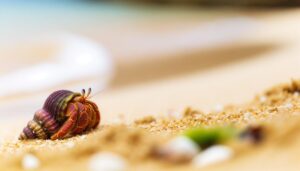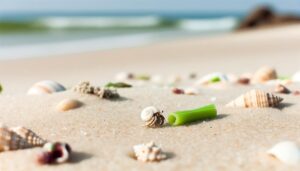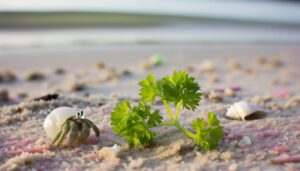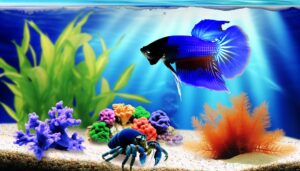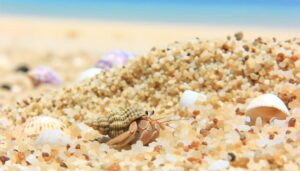How to Do Hermit Crabs Smell Bad in Their Habitat?
Hermit crabs don't just shed their skin; they molt by shedding their exoskeleton. This process, known as ecdysis, involves forming a new, larger exoskeleton.
Molting is important for growth and limb regeneration. You'll notice signs like increased burrowing, reduced appetite, and a dull exoskeleton when they're about to molt.
Maintaining a moist environment with plenty of calcium sources is essential for successful molting. Post-molting, crabs consume their shed exoskeleton to reabsorb essential nutrients.
To make sure your hermit crab molts properly, you'll need to closely manage its habitat and diet. Continue exploring to grasp the full intricacies of this fascinating process.
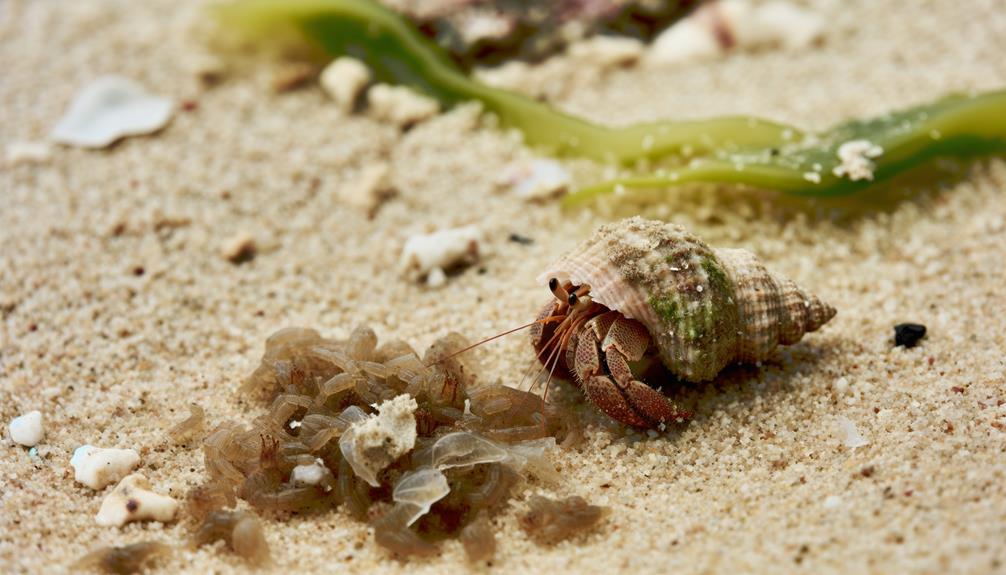
Key Takeaways
- Hermit crabs molt, shedding their entire exoskeleton, not just skin fragments.
- Molting involves replacing the old exoskeleton with a new, larger one.
- The process includes creating a burrow and showing behavioral changes like lethargy.
- Hermit crabs require a moist, calcium-rich environment for successful molting.
- Post-molt, they consume their exuviae to reclaim essential nutrients.
Understanding Hermit Crab Molting
Hermit crab molting is a pivotal process for growth and health. It involves the shedding of their exoskeleton to form a new, larger one. During this period, you'll observe your hermit crab exhibiting lethargy and digging into the substrate to create a molting burrow.
It's imperative to provide a moist, calcium-rich environment, as moisture aids in the exoskeleton's softening, and calcium is essential for forming the new one. Molting frequency depends on age and size; juvenile crabs molt more often than adults.
A successful molt is fundamental for your hermit crab's longevity and wellbeing. Monitoring their diet and habitat conditions ensures they receive the necessary nutrients and environment to thrive through this demanding physiological process.
Difference Between Molting and Shedding
You might think molting and shedding are interchangeable, but they describe distinct processes in hermit crabs.
Molting involves complex physiological changes, including the reabsorption of calcium and the formation of a new exoskeleton.
Molting Process Explained
Understanding the molting process in hermit crabs involves distinguishing it from mere skin shedding. Molting entails a complex series of physiological changes crucial for growth and survival. During molting, hermit crabs undergo ecdysis, where they shed their exoskeleton to form a new, larger one.
This process includes the reabsorption of calcium from the old exoskeleton to strengthen the new one. Hermit crabs burrow to create a safe environment, reducing stress and exposure to predators. You'll notice changes in behavior such as lethargy and reduced appetite, indicative of an impending molt.
Shedding Vs. Molting
Distinguishing between shedding and molting is essential, as shedding refers to the routine loss of small skin fragments, whereas molting involves a complete exoskeleton replacement accompanied by substantial physiological changes.
When hermit crabs molt, they undergo ecdysis, a process where they shed their entire exoskeleton in one piece. This allows for growth and regeneration of lost limbs.
Shedding, however, is a more superficial, ongoing process that doesn't impact the crab's overall physiology significantly. Understanding this distinction helps you provide appropriate care, ensuring you recognize when a crab is in a vulnerable molting stage versus routine shedding.
This knowledge enhances your ability to support their health and well-being effectively, fostering a more empathetic and informed approach to their care.
Signs of Molting
Molting in hermit crabs is marked by distinct physiological and behavioral changes that signal the onset of ecdysis. You'll notice increased digging activity as they prepare an underground chamber for the vulnerable molting phase.
Hermit crabs often exhibit lethargy and reduced appetite, conserving energy for the demanding process of ecdysis. Their exoskeleton may appear dull or ashy, indicating imminent shedding.
Unlike simple skin shedding, molting involves the complete renewal of the exoskeleton, necessary for growth. Post-molt, hermit crabs consume their exuviae to reclaim essential nutrients like calcium.
Understanding these signs helps you can provide best care. By differentiating molting from shedding, you'll adeptly support their health during this critical life stage.
Why Hermit Crabs Molt
Hermit crabs molt because shedding their exoskeleton is crucial for growth and repairing damaged tissue. When they molt, they discard their old, restrictive exoskeleton to allow for increased body mass and healing. This process is important for their survival and well-being. Molting frequency depends on age, size, and environmental conditions.
| Factor | Description | Impact on Molting Frequency |
|---|---|---|
| Age | Younger crabs molt more frequently | Higher frequency in juveniles |
| Size | Larger crabs molt less often | Lower frequency in adults |
| Environment | Ideal conditions like humidity and temperature | Promotes regular molting cycles |
Understanding why hermit crabs molt helps you provide the best care, ensuring their habitat meets these crucial needs. By fostering the right environment, you support their natural growth and health.
Signs Your Hermit Crab Is Molting
You'll notice your hermit crab exhibiting specific behavioral changes such as reduced activity and burrowing more frequently.
Physical indicators include a duller exoskeleton and whitish, translucent gel limbs.
These signs are critical for understanding when your hermit crab is entering the molting phase.
Behavioral Changes During Molting
During the molting process, you'll notice your hermit crab displaying specific behavioral changes indicative of this significant phase in its life cycle. They often exhibit increased burrowing activity, seeking isolation to create a secure molting burrow.
You might also observe decreased appetite as metabolic demands shift. Additionally, reduced movement and lethargy are common, as energy is conserved for the molting process. It's essential to monitor these behaviors closely, as they signal the need for a stress-free environment.
Physical Indicators of Molting
One clear physical indicator of molting is the appearance of a white, translucent exoskeleton as your hermit crab begins to shed its old skin.
You may also notice other signs that confirm the molting process. These indicators are vital for ensuring the well-being of your hermit crab.
- Swollen Abdomen: The abdomen appears distended due to the buildup of fluids.
- Cloudy Eyes: Eyes may look misty or cloudy, indicating internal changes.
- Lethargy: Noticeable decrease in activity as energy is diverted to molting.
- Burrowing Behavior: Increased digging as they seek a safe place to molt.
- Shedding Limbs: Sometimes, old limbs are shed and new ones grow in their place.
The Molting Process Explained
Hermit crabs undergo a complex molting process, which involves shedding their exoskeleton to allow for growth and regeneration. During this process, they'll secrete enzymes to separate the old exoskeleton from the underlying skin. You'll notice increased lethargy and burrowing behavior as they prepare for this crucial phase. The molting cycle consists of several stages, each essential for successful exoskeleton regeneration.
| Stage | Description |
|---|---|
| Pre-Molt | Preparation phase, secretion of enzymes |
| Ecdysis | Shedding of the old exoskeleton |
| Post-Molt | Hardening of the new exoskeleton |
| Inter-Molt | Normal activities, growth slows down |
| Regeneration | Repair and regrowth of lost limbs |
Understanding these steps allows you to better support your hermit crab through its molting journey.
Preparing for a Successful Molt
To guarantee a successful molt, you must create a safe environment and provide essential nutritional support. Maintaining ideal humidity and temperature levels minimizes stress and promotes proper shedding.
Additionally, a diet rich in calcium and other crucial nutrients strengthens the exoskeleton and prepares the crab for the molting phase.
Creating a Safe Environment
Achieving a successful molt for your hermit crab requires careful preparation of their habitat to minimize stress and potential hazards. Start by creating a controlled environment that simulates their natural ecosystem. Use evidence-based practices to ensure ideal conditions.
- Substrate Depth: Maintain a substrate depth of at least 6 inches to enable safe burrowing.
- Humidity Levels: Keep humidity between 70-80% to prevent desiccation of the exoskeleton.
- Temperature Regulation: Maintain a stable temperature range of 75-85°F to support metabolic activities.
- Isolation Zones: Provide isolation zones to protect vulnerable molting crabs from tank mates.
- Minimal Disturbance: Avoid handling or disturbing the crab during the pre-molt and molting stages.
Nutritional Support Essentials
Providing best nutritional support is vital for a hermit crab's successful molt, as deficiencies can lead to complications or incomplete exoskeleton formation. You should guarantee a balanced diet rich in calcium, protein, and essential vitamins. Calcium is crucial for exoskeleton hardening, while protein aids in tissue regeneration.
Here's a concise guide:
| Nutrient | Example Foods | Function |
|---|---|---|
| Calcium | Cuttlefish bone | Exoskeleton strengthening |
| Protein | Boiled eggs, fish | Tissue and muscle development |
| Vitamins | Fresh fruits | Overall health and immune support |
| Minerals | Seaweed, algae | Cellular functions and metabolism |
Nutritional Needs During Molting
During the molting process, hermit crabs require a diet rich in calcium and other essential nutrients to support exoskeleton regeneration. Ensuring they receive sufficient nutrition is crucial for their health and successful molting. You should provide a variety of food sources to meet their dietary needs.
Key nutrients include:
- Calcium: Crucial for exoskeleton formation; sources include cuttlebone and crushed oyster shells.
- Protein: Supports tissue growth and repair; offer boiled eggs and lean meats.
- Carotenoids: Enhance pigmentation and overall health; provide carrots and sweet potatoes.
- Omega-3 fatty acids: Promote cellular health; include fish oil supplements.
- Chitin: Essential for exoskeleton strength; feed shrimp shells or cricket exoskeletons.
Creating a Safe Molting Environment
Creating a safe molting environment for hermit crabs involves maintaining ideal humidity and temperature levels to facilitate successful exoskeleton shedding. Ensure the habitat's moisture remains between 70-80%, using a hygrometer for accuracy. Temperature should be regulated between 75-85°F, employing a thermostat-controlled heater.
Substrate depth is essential; provide at least 6 inches of damp sand or coconut fiber to allow the crabs to burrow comfortably. Isolate molting crabs from others to prevent stress and potential harm. Additionally, reduce light exposure and maintain a peaceful environment to mimic their natural habitat.
Common Molting Challenges
Despite meticulous preparations for a safe molting environment, hermit crabs often encounter common challenges such as incomplete molts, stress from relocation, and susceptibility to bacterial infections. These issues can severely impact their health and longevity. You'll need to be vigilant and proactive to mitigate these risks.
Common molting challenges include:
- Incomplete molts: Sometimes, crabs can't fully shed their exoskeleton, leading to entrapment and potential mortality.
- Stress from relocation: Moving to a new environment can cause significant stress, hindering the molting process.
- Bacterial infections: Open wounds from molting are susceptible to pathogenic bacteria.
- Inadequate humidity: Proper humidity levels are essential for a successful molt.
- Nutritional deficiencies: Lack of essential nutrients can impede the molting process.
Post-Molt Recovery
Ensuring proper post-molt recovery is important for a hermit crab's health and requires a controlled environment with ideal humidity, nutrition, and minimal stress factors. After molting, hermit crabs need a quiet and dark habitat to regenerate their exoskeletons effectively. Regularly monitor their enclosure to maintain a humidity level between 70-80% and a temperature of 75-85°F. Providing a balanced diet rich in calcium and protein promotes robust exoskeleton development. Here's a quick reference table to aid in post-molt care:
| Factor | Ideal Range | Importance |
|---|---|---|
| Humidity | 70-80% | Prevents dehydration |
| Temperature | 75-85°F | Supports metabolic processes |
| Nutrition | High calcium, protein | Strengthens new exoskeleton |
| Environment | Quiet, dark | Reduces stress and promotes healing |
Behavior Changes During Molting
During the molting process, hermit crabs exhibit distinct behavioral changes, such as reduced activity and increased burrowing. You'll notice they become less interactive and seek secluded spots. This behavior is driven by their need for protection and stability while their exoskeleton hardens.
Key behavioral changes include:
- Decreased Mobility: Hermit crabs minimize movement to conserve energy.
- Burrowing: Increased digging to create a private, safe molting chamber.
- Reduced Eating: They often fast to focus energy on molting.
- Isolation: They avoid other crabs to reduce stress and potential conflicts.
- Surface Shedding: You might see shed exoskeleton parts near their burrow.
Understanding these behaviors helps you provide a supportive environment during this pivotal phase.
Molting Frequency in Hermit Crabs
Molting frequency in hermit crabs varies based on factors like age, species, and environmental conditions. Juvenile hermit crabs generally molt more frequently, often every few months, while adults may molt once or twice a year.
Species-specific differences also affect molting intervals; for example, Coenobita clypeatus tends to molt less frequently compared to Coenobita compressus. Environmental conditions such as temperature, humidity, and diet greatly influence molting cycles. Higher humidity and best temperatures can facilitate more regular molting.
Additionally, a diet rich in calcium and other essential nutrients supports a healthy molting process. By understanding these factors, you can better care for hermit crabs, ensuring their well-being and facilitating their natural molting cycles. This knowledge empowers you to provide the most suitable care.
Importance of Molting for Growth
Understanding the molting frequency in hermit crabs highlights the important role molting plays in their growth and overall health. Molting allows hermit crabs to shed their exoskeleton, facilitating growth and regeneration. During this process, they replace damaged or lost limbs, maintaining their functionality and mobility. Molting also enables the expansion of their soft tissues, which is crucial for their size increase.
To provide the best care for molting hermit crabs, consider the following:
- Provide a moist environment: Proper humidity supports successful molting.
- Offer a variety of shells: Hermit crabs need larger shells post-molt.
- Ensure a nutrient-rich diet: Adequate nutrition aids in exoskeleton development.
- Minimize handling: Reduce stress by limiting interaction during molting.
- Monitor closely: Regularly check for any complications.
Conclusion
As you've learned, molting in hermit crabs isn't just a routine process—it's a dramatic metamorphosis akin to a phoenix rising from the ashes.
This complex cycle, driven by physiological necessity, secures your crab's survival and growth. The signs, behaviors, and recovery intricacies emphasize the significance of this biological marvel.
Understanding and supporting your hermit crab during this tumultuous journey is vital, shifting you from a mere observer to an indispensable ally in their extraordinary transformation.

